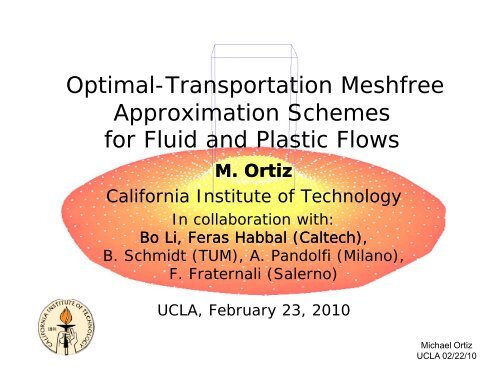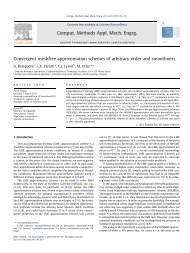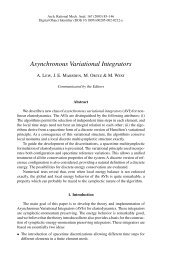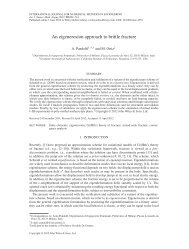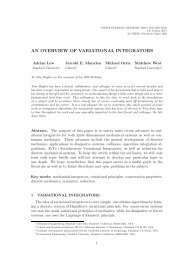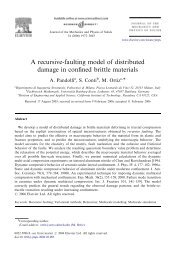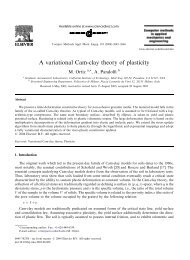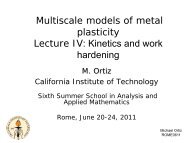Optimal-Transportation Meshfree Approximation Schemes - Solid ...
Optimal-Transportation Meshfree Approximation Schemes - Solid ...
Optimal-Transportation Meshfree Approximation Schemes - Solid ...
You also want an ePaper? Increase the reach of your titles
YUMPU automatically turns print PDFs into web optimized ePapers that Google loves.
<strong>Optimal</strong>-<strong>Transportation</strong> <strong>Meshfree</strong><br />
<strong>Approximation</strong> <strong>Schemes</strong><br />
for Fluid and Plastic Flows<br />
M M. Ortiz<br />
Ortiz<br />
California Institute of Technology<br />
In collaboration with:<br />
Bo Li, Feras Habbal (Caltech),<br />
B. Schmidt (TUM), A. Pandolfi (Milano),<br />
F. Fraternali (Salerno)<br />
UCLA, February 23, 2010<br />
Michael Ortiz<br />
UCLA 02/22/10
ASC/PSAAP Centers<br />
Michael Ortiz<br />
UCLA 02/22/10
Caltech PSAAP Center<br />
Objective: Predict hypervelocity<br />
impact phenomena with quantified<br />
margins and uncertainties<br />
Hypervelocity impact test bumper shield<br />
(Ernst-Mach Institut, Freiburg Germany)<br />
NASA Ames Research Center<br />
E Energy fl flash h from f hypervelocity<br />
h l it<br />
test at 7.9 Km/s<br />
Michael Ortiz<br />
UCLA 02/22/10
QMU – Center’s assets<br />
Experimental Science Simulation codes<br />
SPHIR<br />
HSRT<br />
VTF OTM<br />
Physics models UQ tools<br />
Plasma/EoS Strength/Fracture<br />
Probability/CoM UQ pipeline<br />
Michael Ortiz<br />
UCLA 02/22/10
Simulation requirements<br />
• Hypervelocity impact: Grand challenge in<br />
scientific computing p g<br />
• Main simulation requirements:<br />
– Hypersonic dynamics, high-energy density (HED)<br />
– Multiphase flows (solid, fluid, gas, plasma)<br />
– Free boundaries + contact<br />
– Fracture Fracture, fragmentation, fragmentation perforation<br />
– Complex material phenomena:<br />
• HED/extreme conditions<br />
• Ionization, excited states, plasma<br />
• Multiphase equation of state, transport<br />
• Viscoplasticity, p y, thermomechanical coupling p g<br />
• Brittle/ductile fracture, fragmentation...<br />
Michael Ortiz<br />
UCLA 02/22/10
<strong>Optimal</strong>-<strong>Transportation</strong> <strong>Meshfree</strong> (OTM)<br />
• Time integration (OT):<br />
– <strong>Optimal</strong> transportation methods:<br />
• Geometrically exact, discrete Lagrangians<br />
– Discrete mechanics, variational time integrators:<br />
• Symplecticity, exact conservation properties<br />
– Variational material updates, inelasticity:<br />
• Incremental a variational a a o a structure u u<br />
• Spatial discretization (M):<br />
– Max-ent meshfree nodal interpolation:<br />
• Kronecker-delta property at boundary<br />
– Material-point sampling:<br />
• Numerical quadrature quadrature, material history<br />
– Dynamic reconnection, ‘on-the-fly’ adaptivity<br />
Michael Ortiz<br />
UCLA 02/22/10
<strong>Optimal</strong> transportation theory<br />
Gaspard Monge<br />
Beaune (1746), Paris (1818)<br />
"Sur Sur la théorie des déblais et des<br />
remblais" (Mém. de l’acad.<br />
de Paris, 1781)<br />
Leonid V. Kantorovich<br />
Saint Petersbourg (1912)<br />
Moscow (1986)<br />
Nobel Prize in<br />
Economics (1975)<br />
Michael Ortiz<br />
UCLA 02/22/10
Mass flows ─ <strong>Optimal</strong> transportation<br />
• Flow of non-interacting particles in<br />
• Initial and final conditions:<br />
Michael Ortiz<br />
UCLA 02/22/10
Mass flows ─ <strong>Optimal</strong> transportation<br />
• Benamou & Brenier minimum principle:<br />
• Reformulation as optimal transportation problem:<br />
• McCann’s interpolation:<br />
Michael Ortiz<br />
UCLA 02/22/10
Euler flows ─ <strong>Optimal</strong> transportation<br />
• Semidiscrete action:<br />
inertia internal energy<br />
• Discrete Euler Euler-Lagrange Lagrange equations:<br />
geometrically exact mass conservation!<br />
Michael Ortiz<br />
UCLA 02/22/10
<strong>Optimal</strong>-<strong>Transportation</strong> <strong>Meshfree</strong> (OTM)<br />
• <strong>Optimal</strong> transportation theory is a useful<br />
tool for generating geometrically-exact<br />
geometrically exact<br />
discrete Lagrangians for flow problems<br />
• Inertial part of discrete Lagrangian<br />
measures distance between consecutive<br />
mass densities (in sense of Wasserstein)<br />
• Di Discrete t HHamilton ilt principle i i l of f stationary t ti<br />
action: Variational time integration scheme:<br />
– Symplectic Symplectic, time reversible<br />
– Exact conservation properties (linear and angular<br />
momenta, energy)<br />
– S Strong variational i i l convergence i in the h sense of f Γ-<br />
convergence (B. Schmidt)<br />
Michael Ortiz<br />
UCLA 02/22/10
material<br />
points i<br />
OTM ─ Spatial discretization<br />
nodal points:<br />
Michael Ortiz<br />
UCLA 02/22/10
OTM ─ Spatial discretization<br />
Steel projectile/aluminum plate: Nodal set<br />
Michael Ortiz<br />
UCLA 02/22/10
OTM ─ Spatial discretization<br />
Steel projectile/aluminum plate: Material point set<br />
Michael Ortiz<br />
UCLA 02/22/10
material<br />
points i<br />
OTM ─ Spatial discretization<br />
nodal points:<br />
Question: Q How can we<br />
reconstruct<br />
from nodal coordinates?<br />
Michael Ortiz<br />
UCLA 02/22/10
OTM ─ Max-ent interpolation<br />
• Problem: Reconstruct function from nodal<br />
sample so that:<br />
– Reconstruction is least biased<br />
– Reconstruction is most local<br />
• <strong>Optimal</strong> shape functions (Arroyo & MO, IJNME, 2006):<br />
shape function width information entropy<br />
Michael Ortiz<br />
UCLA 02/22/10
OTM ─ Max-ent interpolation<br />
Michael Ortiz<br />
UCLA 02/22/10
OTM ─ Max-ent interpolation<br />
• Max-ent interpolation is smooth,<br />
meshfree<br />
• Finite-element interpolation is<br />
recovered in the limit of β→∞ β<br />
• Rapid decay, short range<br />
• Monotonicity, maximum principle<br />
• Good mass lumping properties<br />
• Kronecker-delta property at the<br />
boundary:<br />
– Displacement boundary conditions<br />
– Compatibility p y<br />
with finite elements<br />
Michael Ortiz<br />
UCLA 02/22/10
material<br />
points i<br />
OTM ─ Spatial discretization<br />
nodal points:<br />
Michael Ortiz<br />
UCLA 02/22/10
material<br />
points i<br />
OTM ─ Spatial discretization<br />
nodal points:<br />
Michael Ortiz<br />
UCLA 02/22/10
OTM ─ Spatial discretization<br />
Np = local neighborhood<br />
of material point p<br />
Michael Ortiz<br />
UCLA 02/22/10
material<br />
points i<br />
OTM ─ Spatial discretization<br />
nodal points:<br />
• Max-ent interpolation at<br />
material point p determined<br />
by nodes in its local<br />
environment Np<br />
• LLocal l environments<br />
i t<br />
determined ‘on-the-fly’ by<br />
range searches<br />
• Local environments evolve<br />
continuously during flow<br />
(dynamic ( y reconnection) )<br />
• Dynamic reconnection<br />
requires no remapping of<br />
history variables!<br />
Michael Ortiz<br />
UCLA 02/22/10
OTM ─ Flow chart<br />
(i) Explicit nodal coordinate update:<br />
(ii) Material point update:<br />
position:<br />
deformation:<br />
volume: ol me<br />
density:<br />
(iii) Constitutive update at material points<br />
(iv) ( ) Reconnect nodal and material p points ( (range g<br />
searches), recompute max-ext shape functions<br />
Michael Ortiz<br />
UCLA 02/22/10
velocity (m/s) (<br />
tip<br />
OTM ─ Tensile stability<br />
velocity (m/s) (<br />
tip<br />
time (s) time (s)<br />
Finite elements OTM<br />
OTM is free from tensile instabilities!<br />
Michael Ortiz<br />
UCLA 02/22/10
(Kg/m ) 3 )<br />
density<br />
OTM ─ Riemann problem<br />
density d L1<br />
error noorm<br />
convergence<br />
rate ~ 1<br />
position (m) mesh size (h)<br />
computed vs. exact<br />
wave structure<br />
density convergence<br />
(L1 norm)<br />
Michael Ortiz<br />
UCLA 02/22/10
OTM ─ Shock tube problem<br />
Shock tube problem – velocity snapshots<br />
Michael Ortiz<br />
UCLA 02/22/10
ocity L error norm<br />
2 vel e<br />
OTM ─ Shock tube problem<br />
convergence g<br />
rate ~ 1<br />
nsity L error normm<br />
1 den e<br />
convergence g<br />
rate ~ 1<br />
mesh size (h) mesh size (h)<br />
velocity convergence<br />
(L2 (L norm)<br />
density convergence<br />
(L1 (L norm)<br />
Shock tube problem – convergence plots<br />
Michael Ortiz<br />
UCLA 02/22/10
OTM ─ Taylor anvil test<br />
t=0 t 0<br />
tt=7.5 7 5 µs<br />
t=15 µs t=28 µs<br />
copper rod<br />
@ 750 m/s<br />
Michael Ortiz<br />
UCLA 02/22/10
OTM ─ Taylor anvil test<br />
t=0 t 0<br />
tt=7.5 7 5 µs<br />
t=15 µs t=28 µs<br />
copper rod<br />
@ 750 m/s<br />
Michael Ortiz<br />
UCLA 02/22/10
OTM ─ Bouncing balloons<br />
FE membrane<br />
OTM fluid<br />
(rubber (rubber, Kapton)<br />
(water (water, air)<br />
Michael Ortiz<br />
UCLA 02/22/10
OTM ─ Bouncing balloons<br />
FE membrane<br />
OTM fluid<br />
(rubber (rubber, Kapton)<br />
(water (water, air)<br />
Michael Ortiz<br />
UCLA 02/22/10
OTM ─ Bouncing balloons<br />
FE membrane<br />
OTM fluid<br />
(rubber (rubber, Kapton)<br />
(water (water, air)<br />
Michael Ortiz<br />
UCLA 02/22/10
OTM ─ Bouncing balloons<br />
FE membrane<br />
OTM fluid<br />
(rubber (rubber, Kapton)<br />
(water (water, air)<br />
Michael Ortiz<br />
UCLA 02/22/10
OTM ─ Terminal ballistics<br />
steel projectile<br />
1500 m/s<br />
aluminum plate<br />
Michael Ortiz<br />
UCLA 02/22/10
OTM ─ Seizing contact<br />
body 1 body 2<br />
nodes<br />
material points<br />
Seizing contact (infinite friction)<br />
is obtained for free in OTM!<br />
(as in other material point methods)<br />
linear<br />
momentum<br />
cancellation! ll ti !<br />
Michael Ortiz<br />
UCLA 02/22/10
OTM ─ Seizing contact<br />
body 1 body 2<br />
nodes<br />
material points<br />
Seizing contact (infinite friction)<br />
is obtained for free in OTM!<br />
(as in other material point methods)<br />
linear<br />
momentum<br />
cancellation! ll ti !<br />
Michael Ortiz<br />
UCLA 02/22/10
Variational Fracture & fragmentation<br />
M. Ortiz and A.E. Giannakopoulos,<br />
Int. J. Fracture, 44 (1990) 233-258.<br />
Michael Ortiz<br />
UCLA 02/22/10
Variational Fracture & fragmentation<br />
rate (G)<br />
-release r<br />
Energy-<br />
crack extension (Δa)<br />
M. Ortiz and A.E. Giannakopoulos,<br />
Int. J. Fracture, 44 (1990) 233-258.<br />
Michael Ortiz<br />
UCLA 02/22/10
OTM – Fracture & fragmentation<br />
Crack growth in mixed mode<br />
M. Ortiz and A.E. Giannakopoulos,<br />
Int Int. J J. Fracture Fracture, 44 (1990) 233 233-258. 258<br />
• Fracture energy over-estimated as h → 0!<br />
• Non Non-convergence con e gence fo for gene general al paths, paths meshes!<br />
Michael Ortiz<br />
UCLA 02/22/10
OTM – Fracture & fragmentation<br />
ε-neighborhood<br />
g<br />
construction<br />
Michael Ortiz<br />
UCLA 02/22/10
Variational Fracture & fragmentation<br />
crack<br />
• Proof of convergence of<br />
variational i ti l element l t erosion i t to<br />
Griffith fracture:<br />
– Schmidt, , B., , Fraternali, , F. and<br />
Ortiz, M. “Eigenfracture: An<br />
eigendeformation approach to<br />
variational fracture,” SIAM J.<br />
Multiscale Model. Simul., 7(3)<br />
(2009) 1237-1366.<br />
• OTM implentation: p<br />
Variational<br />
erosion of material points (by<br />
ε-neighborhood construction)<br />
Michael Ortiz<br />
UCLA 02/22/10
OTM ─ Back to terminal ballistics<br />
steel projectile<br />
1500 m/s<br />
aluminum plate<br />
Michael Ortiz<br />
UCLA 02/22/10
QMU – Simulation codes – OTM<br />
Michael Ortiz<br />
UCLA 02/22/10
QMU – Simulation codes – OTM<br />
Michael Ortiz<br />
UCLA 02/22/10
QMU – Simulation codes – OTM<br />
Michael Ortiz<br />
UCLA 02/22/10
QMU – Simulation codes – OTM<br />
eriment<br />
expe<br />
simulationn<br />
Michael Ortiz<br />
UCLA 02/22/10
OTM ─ Summary and outlook<br />
• Optimum-<strong>Transportation</strong>-<strong>Meshfree</strong> method:<br />
– OT is a useful tool for generating geometrically-<br />
geometrically<br />
exact discrete Lagrangians for flow problems<br />
– Max-ent approach supplies an efficient meshfree,<br />
continuously adaptive adaptive, remapping remapping-free, free FEcompatible,<br />
interpolation scheme<br />
– Material-point sampling effectively addresses the<br />
iissues of f numerical i l quadrature, d hi history variables i bl<br />
• Extensions include:<br />
– Contact (seizing contact for free!)<br />
– Fracture and fragmentation (provably convergent)<br />
• Outlook: Parallel implementation, p , UQ… Q<br />
Michael Ortiz<br />
UCLA 02/22/10
OTM ─ Summary and outlook<br />
Thank you! y<br />
Michael Ortiz<br />
UCLA 02/22/10


